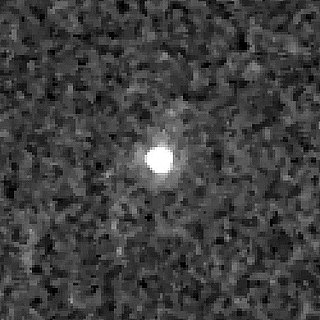Top Qs
Timeline
Chat
Perspective
(42301) 2001 UR163
From Wikipedia, the free encyclopedia
Remove ads
(42301) 2001 UR163 (provisional designation 2001 UR163) is a resonant trans-Neptunian object located in the outermost region of the Solar System. The object measures approximately 352 kilometers (220 miles) in diameter with a high albedo and stays in an uncommon orbital resonance (4:9) with Neptune. It was discovered on 21 October 2001 by astronomers of the Deep Ecliptic Survey program at Kitt Peak National Observatory near Tucson, Arizona, United States. As of 2021[update], it has not been named.[1]
Remove ads
Classification and orbit
The object orbits the Sun at a distance of 37.0–66.6 AU once every 372 years and 12 months (136,232 days; semi-major axis of 51.82 AU). Its orbit has an eccentricity of 0.29 and an inclination of 1° with respect to the ecliptic.[3] It came to perihelion on 8 October 1937, and has since been moving away from the Sun.[3] In 2006, it moved beyond a distance of 50 AU and is at 53.7 AU as of 2021[update].[9] The body's observation arc begins with a precovery, published by the Digitized Sky Survey and taken at the Siding Spring Observatory in July 1982.[1]
Remove ads
Numbering and naming
2001 UR163 was numbered (42301) by the Minor Planet Center on 26 May 2002 (M.P.C. 45686).[10] As of 2025[update], it has not been named.[1] According to the established naming conventions, it will receive a mythological or mythic name (not necessarily from Classical mythology), in particular one associated with creation.[11]
Physical characteristics
Lightcurve analysis shows only small deviations, suggesting that 2001 UR163 is a spheroid with small albedo spots.[12] Observations with Spitzer's Infrared Array Camera were used to study the body's surface composition. The analyzed data indicate the presence of 20% water ice, 60% amorphous silicates, and 20% organic compounds, including complex ones such as tholins.[6]: 20
Diameter and albedo
2001 UR163 measures approximately 352 kilometers (220 miles) in diameter with a high albedo of 0.209.[4][6]: 26
Based on previous estimates published on the Lightcurve Data Base and on Michael Brown's website, 2001 UR163 measures between 531 km (330 mi) and 583 kilometers (360 miles), using an assumed intermediate surface albedo of 0.09 to 0.10 with an absolute magnitude of 4.49 and 4.4, respectively.[7][13]
See also
References
External links
Wikiwand - on
Seamless Wikipedia browsing. On steroids.
Remove ads

